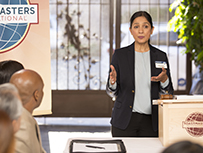
For some reason, the idea of being picked to speak in front of a group with no time to prepare is terrifying. Can we as Toastmasters manage this fear and, dare I say it, master it through Table Topics®?
Clearly, we can. Table Topics has been a traditional club exercise for decades, and gives us the chance to practice spontaneous speaking skills at every meeting.
If you’re new to Toastmasters, here’s a quick overview of how it works: The Topicsmaster gathers a variety of subjects and then calls on meeting attendees to speak on the topic for one to two minutes. This exercise helps speakers learn to organize their thoughts quickly into a clear response. Essentially, Table Topics responses are “mini-speeches” and, like any bit of good oratory, should contain an opening, body, and closing.
Ultimately, the point of Table Topics is that both the Topicsmaster and the participant play an important role in ensuring everyone benefits and grows from each session.
Here’s a look at how that happens for Toastmasters on both sides of the “table.”
Tips for Participants
When asked why they fear impromptu speaking, many Toastmasters say it’s because they’re uncomfortable speaking on a topic they know nothing about. Bunmi Okuwa, with Niagara On The Lake Toastmasters in Ontario, Canada, found herself in this situation when she first tried Table Topics. “My greatest fear was that I’d have to make things up on the spot, which usually made me very nervous,” she says.
Despite the initial fear factor, the most important confidence-builder by far is to simply practice as often as possible. As with formal speeches, we improve by doing. Every time we give a Table Topics response, our confidence grows. We learn to relax and take our time in responding.
One tactic to reduce stress is to reframe your response as a conversation, rather than a performance, suggests Matt Abrahams, a lecturer in organizational behavior at Stanford University’s graduate business school, and author of Speaking Up Without Freaking Out. “The idea of a ‘performance’ comes with a tremendous amount of pressure to deliver an Oscar-winning response. Instead, by thinking of our communication as a conversation, we can reduce stress and become more engaged. Because there’s no one ‘right way’ to have a conversation, this lens helps speakers focus on the audience and their needs, thus reducing their own self-focused anxiety,” he explains.
Tracey Rogers, Vice President Education for Windsor Speakers Club in Windsor, England, suggests a similar tactic. “Start with your opinion,” she says. “This helps reduce stress as you already know your personal opinion on the topic, so you can start responding with confidence.”
Toastmasters can also learn a great deal by observing how other members manage Table Topics responses.
“I pay attention to my mentor Charles; the ease and confidence with which he responds is a skill set that I look forward to attaining,” says the Niagara club’s Okuwa.
Tips for Topicsmasters
It’s the job of the Topicsmaster to give as many attendees as possible the chance to speak and practice and to ensure the meeting stays on time during the activity. As with any meeting role, the more you prepare, the more successful you will be.
Before the meeting, get the agenda from the Vice President Education to see how much time has been allotted for the session. Subtract a few minutes for your opening and closing comments, and then divide the remaining time by three (two minutes for responses plus one minute for transitions between speakers). This gives you a good idea of how many participants can join the session.
Prepare enough questions for the group; include a few extras in case you have additional time. As Topicsmaster, you may ask for volunteers. Otherwise, call on participants who don’t have a speaking role at the meeting. Next, choose those with minor roles, then guests. Last but not least—if time allows—call on members who have meeting roles or are delivering formal speeches that day.
Wait until a few participants have spoken before choosing a guest, so they have a chance to see how it is done. Always ask guests if they want to participate and if they decline, simply say, “That’s fine. Maybe next time,” and move to the next person. When a guest does agree to speak, be sure to review the rules and explain how the timing system works before giving them the topic. Some clubs give the topic/question first and then pick a participant. This is a great way to let every member think about a possible response, since they never know when or if they will be called upon.
Start with your opinion. This helps reduce stress as you already know your personal opinion on the topic, so you can start responding with confidence.
—Tracey RogersBe aware of cultural or language differences. Make sure the speaker is able to understand the topic you’re giving them. One way to do this is to relate the topic to the speaker’s experience. For example: “In many countries, people dress up in costumes for celebrations. Can you tell us about a time you wore a costume and why?”
The goal of Table Topics is to build speaker self-confidence. As the Topicsmaster, you want to set up each speaker for success, so try to match the topic to the participant’s experience level. For guests and newer members, use a basic topic, such as: “Tell us about what you like to do on vacation.” The objective is to get the person to participate and feel good about doing so. Keep an eye on the time and be sure to end the Table Topics session a few minutes early, to allow time for voting and to get the timer’s report.
Table Topics offer great opportunities for creativity. One club, for example, put a new “spin” on their online session by building a virtual wheel with numbers and corresponding topics. The Topicsmaster would spin the wheel for each participant, who then spoke on the topic where the wheel landed. It was a lot of fun and a great way to add some variety to the meeting.
So, who grows the most from Table Topics speeches—Topicsmasters or participants? For me, the answer is both. No matter which side of the table we are representing, we all improve our confidence with impromptu speaking and help our club have a successful meeting.
Greg Lewis, DTM is a retired business professional who strives to inspire and encourage his fellow Toastmasters. He and his family live in Fonthill, Ontario, Canada.
Related Articles

Table Topics
10 Tips for Terrific Table Topics

Meeting Roles
Creative Tips for the Topicsmaster

Table Topics
Shake Up Table Topics With Creative Ideas

Meeting Roles


 Previous
Previous

 Previous Article
Previous Article